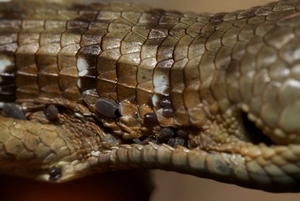Biology:Mite pocket

A mite pocket is an area on the body of a lizard that serves to concentrate biting mites such as chiggers and ticks.[1] They are slight depressions on the body, usually behind other appendages such as the legs and neck. These areas have smaller scales and increased blood vessels to entice the parasites to move there, while also being able to regenerate itself quickly, thus localizing the damage to only one part of the lizard's body.[2][3]
This feature has evolved independently in five families of lizard and over 150 species of lizards,[2] and are in particular most common in places that are warm and moist.[1] For example, in western North America, Sceloporous species from the lowlands have evolved mite pockets due to the abundance of ticks in those habitats, while Callisaurus and Uta species that live in arid deserts do not need them.[4]
References
- ↑ 1.0 1.1 Arnold, E.N. (September 1986). "Mite pockets of lizards, a possible means of reducing damage by ectoparasites". Biological Journal of the Linnean Society 29 (1): 1–21. https://academic.oup.com/biolinnean/article-abstract/29/1/1/2676944.
- ↑ 2.0 2.1 Elmer, Nicole (27 October 2021). "All things creepy: parasitism pt 4, mite pockets". https://biodiversity.utexas.edu/news/entry/mite-pockets.
- ↑ Bertrand (March 2004). "The role of mite pocket-like structures on Agama caudospinosa (Agamidae) infested by Pterygosoma livingstonei sp. n. (Acari: Prostigmata: Pterygosomatidae)". Folia Parasitol (Praha) 51 (1): 61–66. PMID 15139379. https://pubmed.ncbi.nlm.nih.gov/15139379/.
- ↑ Reed, Jay Clark (2014). "Analysis of the Function and Evolution of Mite Pockets in Lizards.". University of Michigan Library. https://deepblue.lib.umich.edu/handle/2027.42/107203.
 |

